You'll find winter sun time meals most successful when you align your cooking with ideal sun positioning and weather patterns. Position your setup 15° west to 20° east of true north, and use thermal mass materials to retain precious heat longer. You'll want to adapt recipes for heartier, nutrient-dense foods like root vegetables while incorporating high-fat ingredients for sustained warmth. Smart meal planning around shorter daylight hours and batch cooking during peak sunlight helps maximize efficiency. Don't forget to keep backup cooking methods handy for cloudy days. The deeper you explore these strategies, the more you'll master the art of winter sun cooking.
Optimal Winter Sun Positioning
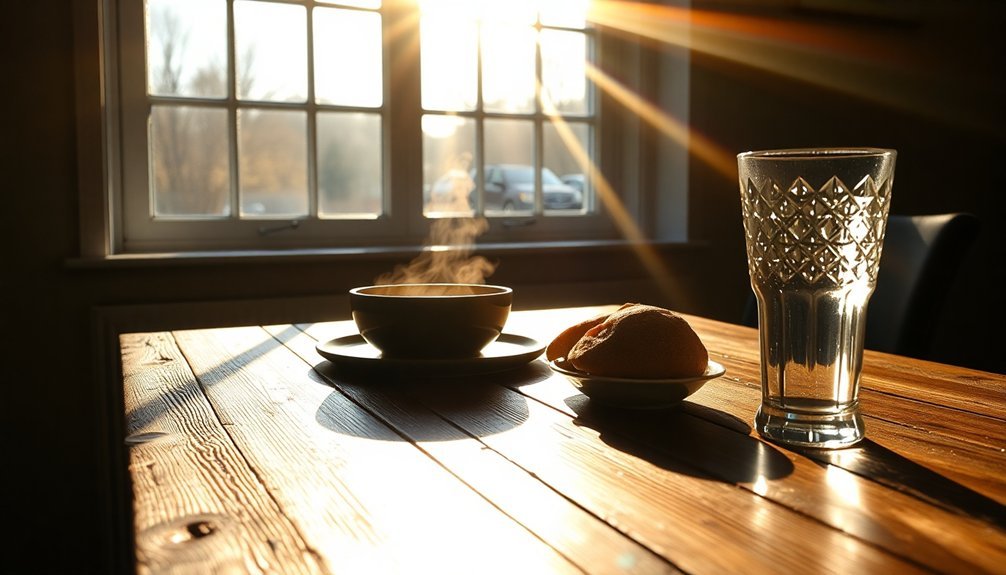
The ideal positioning for winter sun exposure requires careful consideration of both building orientation and panel angles.
You'll want to position your living spaces within 15° west and 20° east of true north to maximize natural heating. During winter months, the sun travels a lower path across the southern sky, making north-facing windows particularly valuable for capturing warmth.
For solar panels, you'll need to balance between ambient light capture and snow management. While a 60-degree tilt might seem ideal for direct winter sunlight, a more moderate 10-20 degree angle often works better. Regular monitoring with a digital voltmeter (DVM) can help you assess and optimize your panel's performance over time.
This compromise allows panels to capture diffused light on cloudy days while still enabling snow to slide off naturally. Remember that proper positioning can cut your heating costs by 10-40%, making it worth the effort to get it right.
Weather Pattern Planning
Planning your winter meals around weather patterns requires understanding both seasonal produce availability and traditional preservation methods.
You'll need to monitor weather forecasts to make the most of your cooking schedule, especially when using stored root vegetables and preserved foods from previous seasons.
When harsh winter weather approaches, you're better off preparing hearty soups and stews that can be easily reheated.
Stock your pantry with winter squash, beets, parsnips, and other root vegetables that store well. You can use an Instant Pot on particularly cold days to minimize cooking time and add warmth to your kitchen.
During brief periods of winter sunlight, you'll want to maximize your food preparation time by batch cooking meals that can be preserved for later use. This approach helps create cost-effective meals while ensuring nutritious options throughout the winter season.
Heat Retention Methods
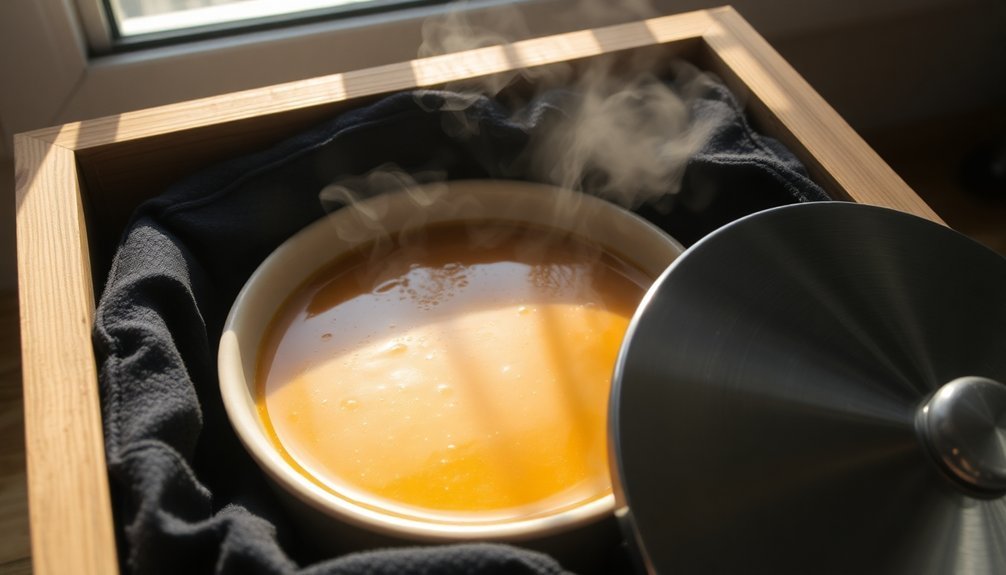
Successfully preserving heat during winter solar cooking requires understanding both passive and active retention methods.
You'll want to start by using thermal mass materials that can store heat from the sun and release it gradually throughout your cooking process. Insulated pots and oven roasting bags will help maintain consistent temperatures. Place bricks or blocks underneath to stabilize against winter winds.
Make the most of greenhouse effects by strategically positioning your cooker and opening curtains to naturally warm your cooking area.
You can enhance heat capture by placing reflective surfaces around your solar cooker to concentrate more sunlight. Preheating your cookware before adding ingredients will give you a head start on temperature retention.
Remember to create good airflow around your cooking setup, as proper convection helps distribute heat evenly and maintains ideal cooking conditions.
Seasonal Recipe Adaptations
Adapting recipes for winter sun cooking requires strategic changes to both ingredients and preparation methods.
You'll need to focus on hearty, nutrient-dense foods that retain heat well and provide sustained energy during cold months. Following proper winter dietary guidelines helps maintain optimal hormonal balance during the cold season.
- Choose dense root vegetables like potatoes, carrots, and beets – they're perfect for solar cooking as they maintain temperature and pack essential nutrients.
- Incorporate high-fat ingredients such as grass-fed butter or coconut oil to help dishes stay warmer longer.
- Use preserved ingredients like canned tomatoes or dried herbs to enhance flavor when fresh options aren't available.
- Transform traditional recipes into one-pot meals by combining proteins, root vegetables, and hardy greens.
Remember to adjust cooking times for winter's shorter daylight hours and lower sun intensity.
You'll get the best results by starting your solar cooking early in the day when sunlight is strongest.
Backup Cooking Solutions
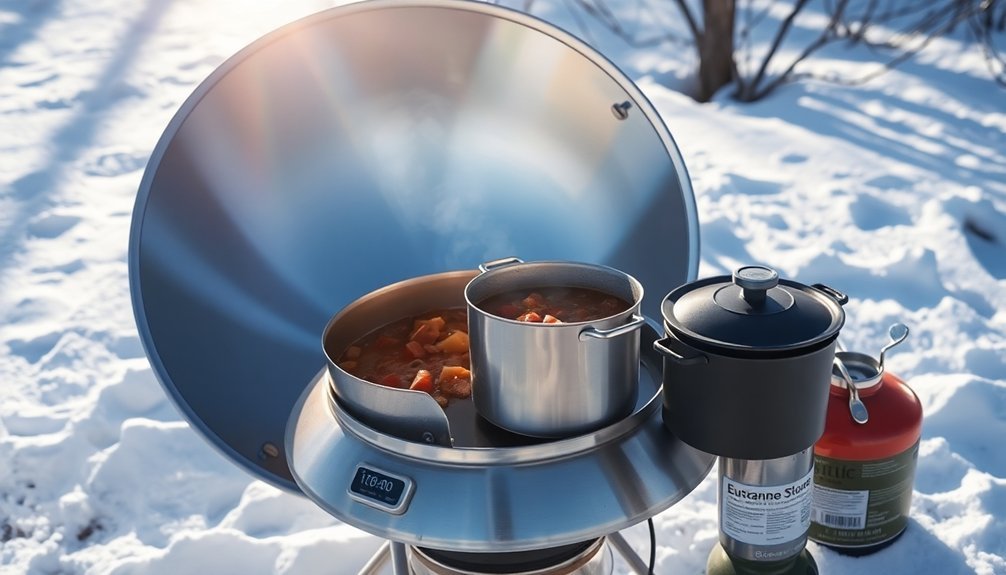
You'll want several backup cooking options when winter storms cut power, including reliable isobutane stoves and simple DIY alternatives like olive oil lamps.
Your emergency heat sources should include a mix of both modern equipment (like remote canister stoves) and basic options (such as hay box ovens and solar cookers) to guarantee you can prepare meals in any situation.
Keep your supplies organized on stable platforms with proper insulation, and store your backup cooking gear in an easily accessible location that won't be blocked by snow or ice.
Emergency Heat Sources
When power outages strike during winter, having reliable backup cooking solutions becomes essential for preparing hot meals and staying warm.
You'll need to choose heat sources that are both safe and effective for indoor use.
- Portable butane stoves and alcohol stoves are your safest indoor options, providing reliable heat with proper ventilation.
- Canned heat and MRE heaters work well for small-scale cooking needs and don't require extensive setup.
- Propane cookers and combination stoves offer versatility, but you'll need adequate ventilation when using them indoors.
- Fireplaces and wood stoves can serve double duty for both cooking and heating, though they require proper maintenance.
Remember to install carbon monoxide detectors and keep firefighting materials nearby.
Store fuel properly and choose a well-ventilated room for cooking to guarantee your safety during emergency situations.
Storage Without Power
Reliable backup cooking solutions make all the difference during power outages, ensuring you can prepare hot meals and maintain a sense of normalcy.
You'll find that portable power stations paired with electric appliances like HotLogic slow cookers and rice cookers offer convenience without fuel concerns.
If you're looking for fuel-based options, butane stoves and Coleman stoves provide versatile cooking capabilities when properly ventilated.
For long-term solutions, consider solar ovens that harness natural energy or Wonder Ovens that use retained heat.
You can't go wrong with a HERC oven using tea lights or a Kelly Kettle for efficient water boiling.
Remember to match your power source's wattage to your appliance needs, and always prioritize proper ventilation when using fuel-based methods indoors.
Winter Equipment Care
Proper equipment care becomes critical during the harsh winter months.
You'll need to protect your cooking equipment from damage, wear, and potential failures that cold weather can cause. Before winter strikes, schedule thorough inspections and address any repairs immediately.
During daily operations, verify you:
- Allow proper warm-up time for all equipment to maintain ideal oil circulation.
- Clean thoroughly after each use, removing snow, ice, and debris that can trap moisture.
- Apply winter-grade grease to pivot points and use rust inhibitors on exposed metals.
- Store equipment in heated spaces when possible, using waterproof covers if outdoor storage is necessary.
Don't forget to periodically run your equipment and circulate fluids, even during storage periods.
Using winter-grade hydraulic fluids and maintaining proper tire pressure will help prevent equipment failures in freezing conditions.
Time Management Strategies
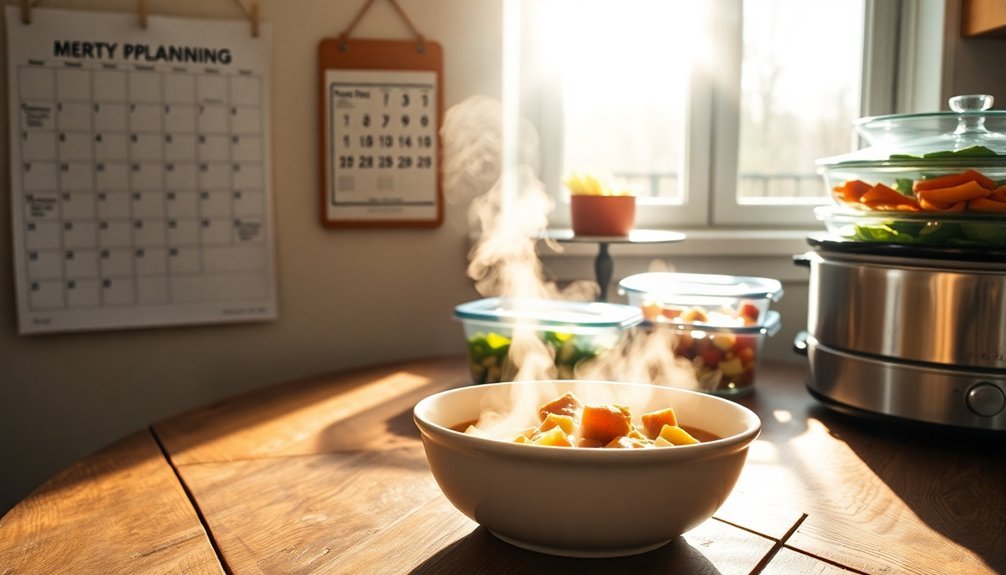
You can maximize winter's limited daylight by preparing your meals during early morning hours, setting yourself up for a more relaxed day.
Strategic batch cooking on weekends lets you create multiple portions that you'll easily reheat throughout the busy workweek.
Planning your meals in advance helps you coordinate cooking times with peak sunlight hours, ensuring you're not scrambling to prepare dinner in darkness.
Early Morning Meal Prep
While the dark winter mornings can make meal preparation feel intimidating, establishing a solid time management strategy will transform your early hours into a productive cooking session.
You'll want to focus on efficiency and planning to maximize your morning meal prep routine.
- Set your timer and dedicate a specific window for prep work – don't let yourself get distracted by other morning tasks.
- Prepare smoothie packs and breakfast bowls in advance to streamline your morning routine.
- Slightly undercook ingredients that you'll reheat later to maintain ideal texture.
- Label and portion your meals immediately to save time during busy weekday mornings.
Stock your pantry with essential ingredients and keep frozen fruits on hand for quick breakfast options.
Remember to use meal prep containers that are easy to grab when you're rushing out the door.
Batch Cooking Success Tips
Successful batch cooking begins with smart time management and the right preparation strategy. You'll want to designate a specific day, like Sunday afternoon, for your batch cooking sessions. Start with a manageable 20-30 minute timeframe and adjust as you become more experienced.
Before you begin cooking, gather all ingredients and equipment you'll need. This prevents time-wasting trips back and forth to your pantry or fridge.
Group similar tasks together – chop all vegetables at once, measure spices in batches, and prep proteins simultaneously. You'll find it's more efficient to slightly undercook foods that will be reheated later.
Keep your serving utensils ready and clean as you go by reversing the order of your ingredient gathering. This systematic approach guarantees smooth, efficient batch cooking sessions.
Strategic Mealtime Planning
Strategic mealtime planning requires a dedicated weekly schedule to maximize efficiency and minimize stress.
You'll want to set aside a specific day, like Sunday, to plan your winter meals and create detailed shopping lists based on store specials.
Consider using meal planning apps to stay organized while tracking ingredients and recipes.
4 Essential Winter Meal Planning Steps:
- Design your menu around seasonal ingredients and weekly store discounts.
- Prep ingredients in advance, including chopping vegetables and marinating proteins.
- Utilize slow cookers and sheet pans for efficient, hands-off cooking.
- Cook proteins in bulk at week's start for multiple meal variations.
Remember to balance nutrition with practicality by choosing recipes that match your cooking skills and available time.
Keep meals interesting by varying preparation methods and incorporating different textures, temperatures, and flavors.
Frequently Asked Questions
How Do Cultural Traditions Influence Winter Sun Meal Planning?
Your cultural traditions shape winter sun meals through family recipes, seasonal ingredients, and symbolic foods. You'll honor heritage by incorporating traditional cooking methods and communal preparation that's been passed down through generations.
What Indoor Activities Can Complement Outdoor Winter Sun Dining?
You can host indoor craft sessions, play family board games, or organize cooking classes before meals. Try storytelling gatherings, DIY karaoke nights, and winter-themed movie marathons to enhance your sun dining experience.
Are There Specific Safety Concerns for Children During Winter Sun Meals?
You'll need to watch for hot beverages that can scald, guarantee proper sun protection even in winter, monitor food temperatures, and keep children away from outdoor cooking equipment like grills or heaters.
Which Tableware Materials Work Best for Winter Sun Dining Experiences?
You'll want to use shatter-resistant melamine or bamboo-blend tableware for outdoor winter sun dining. They're lightweight, durable, and safe. Stoneware's also great if you're dining in a protected area.
Can Winter Sun Meals Help With Seasonal Affective Disorder Symptoms?
Yes, winter sun meals can help manage your SAD symptoms by providing nutrient-rich foods that boost serotonin levels. You'll benefit from regular meal timing and social dining experiences that improve mood and well-being.
In Summary
You'll find winter sun time meals succeed when you've carefully planned and adapted to the season's unique challenges. By positioning your solar cooker efficiently, monitoring weather patterns, and implementing heat retention techniques, you're setting yourself up for success. Don't forget to keep seasonal recipes handy and maintain your equipment properly. With smart time management and reliable backup options, you'll enjoy consistent solar cooking even during shorter winter days.

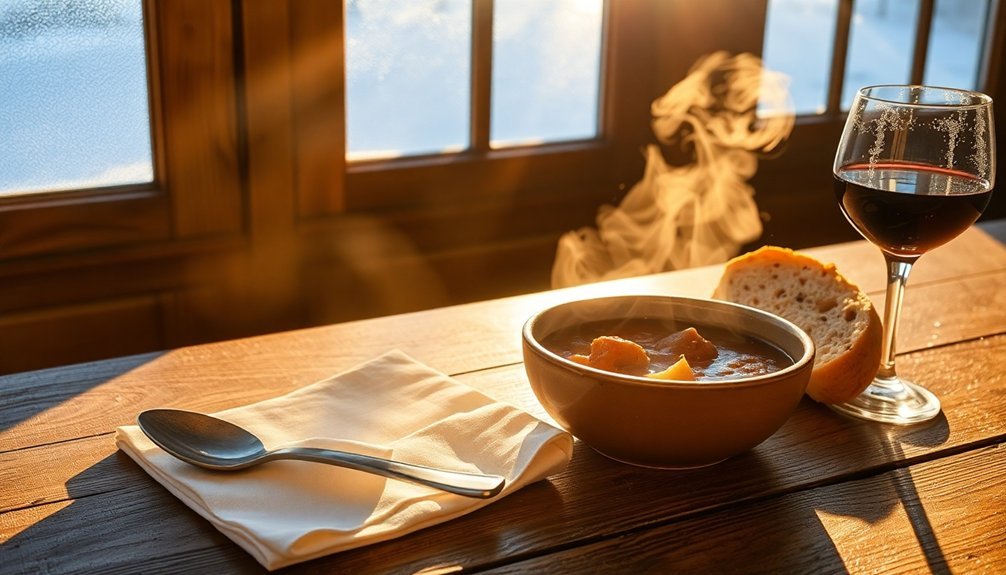
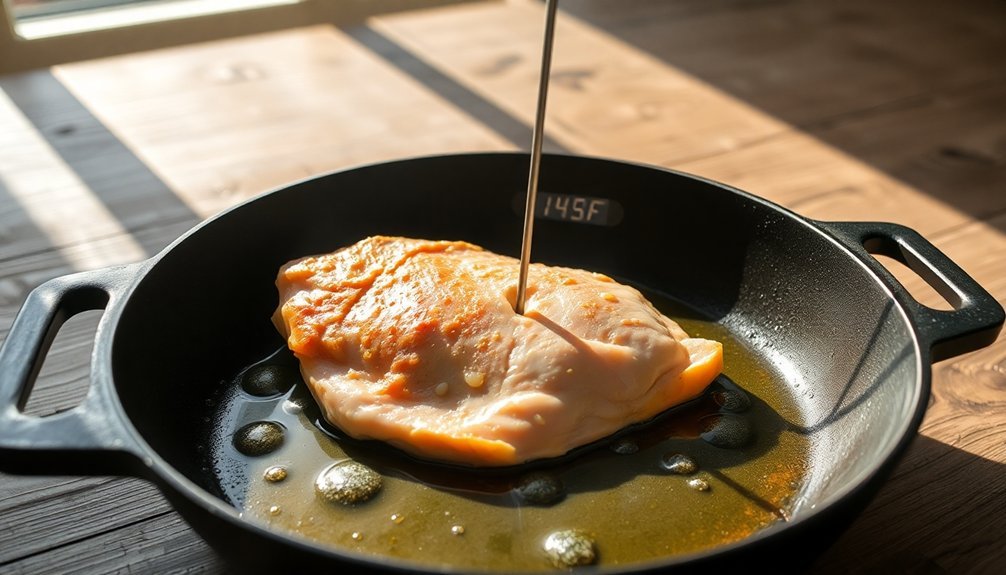
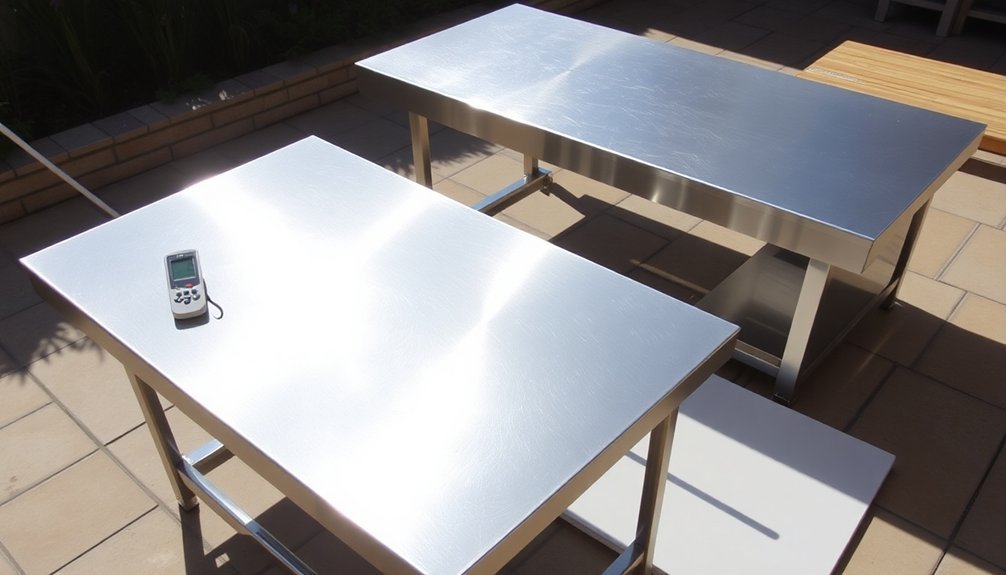
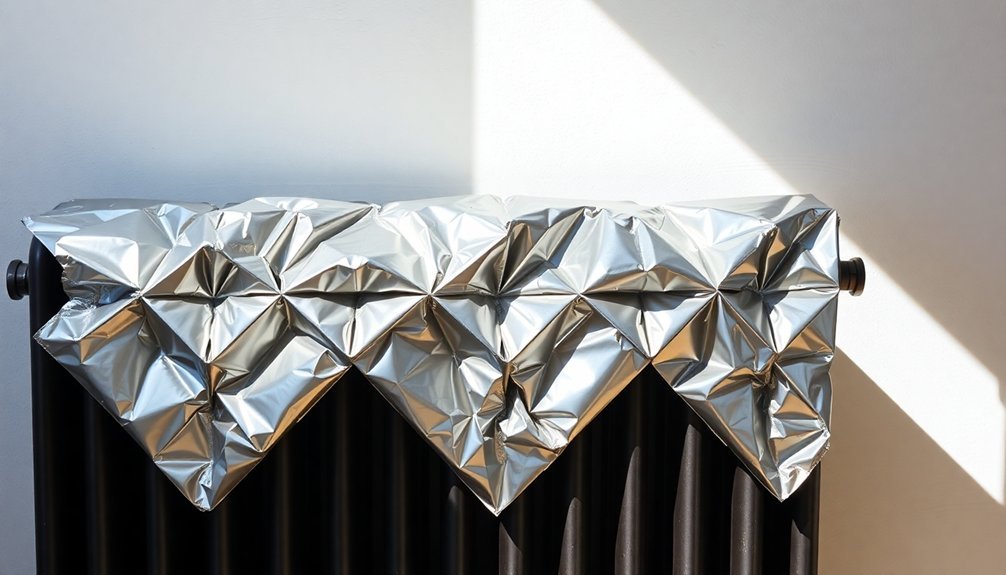
Leave a Reply